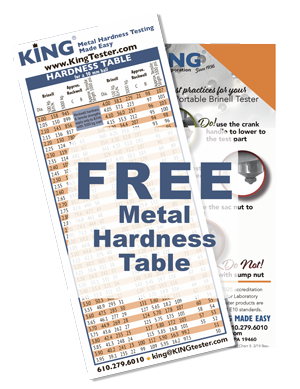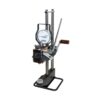Choosing the Right Test Block : Many people operate under a misconception they must use a test block equivalent in hardness to the parts or samples they are testing. This is not the case. While it is wise to choose a test block within a reasonable range of the same hardness you do not need to match the hardness exactly. The Test Block is used to indirectly verify the force being applied by the tester is equivalent to the calibrated force of the tester. This is done by using the tester to apply force to a known metal hardness (the Test Block). The result is then compared to the master indentations on the Test Block to determine if the Tester is applying accurate pressure.
Some of the factors to consider when choosing the right test block are
- Hardness
- Conformance with ASTM standards
- Size
- Ease of Use
- Record keeping
- Cost
Let’s take these factors one at a time
Hardness is the known hardness of the Test Block as certified. Because the hardness of the block is known it can be used to determine the size diameter of indentation made at a given level of force. The Test Block should be within a reasonable range of the hardness of the material to be tested but it does not nee to be exact. Why? Because the tester is being verified for the force it applies to a known hardness. It will apply the same force regardless of the hardness of the test block. Reasonable guidance is to purchase a test block +/- 20 HBW from your parts target hardness. if you want to tighten the range; you can but the result will be the same. The only time the result may vary would be a function of dwell time on softer metal which could influence results. However, you can request a test block within a tighter hardness range.
Conformance with ASTM standards is important and in some case vital. This means the test block has a limited number of indentation opportunities as a function of the requirements for spacing as laid out in ASTM E10. You may only use the designated test surface (no flipping the test block to double the number of indents). King Tester has taken the guess work out of meeting ASTM standards for you with our patented design which makes it simple to punch in the right places.
Size only makes a difference in so far as larger sizes allow you to reduce you cost of verification by more effectively using the real estate on the Test Block. King Tester provides both 4×4 and 2×6 sizes in a wide range of hardnesses.
Ease of use is important for a couple of reasons. The ability to set the Test Block in the right place to make the proper indentation is easier with a grid design. The grid design allows the user to follow the markings and get your indent in the proper spot. Following the grid also reduces the time it takes for the verification.
Record keeping is required to be able to establish the tester force was verified daily. The King patented design contains an index which allow for easy tracking of tests taken. For example; test on Feb 1st was taken at location B2 and February 2nd was at B3 and so on. This replaces the sharpies and guess work and lends itself to more professional record keeping which pleases the auditors.
Cost is always a consideration and best way to measure cost is on a per indentation basis. What is the cost for daily verification? A less expensive test block is nice but if it leads to wasted indentations and fewer indentation per block then the cost may be higher. King Tester’s test blocks holds down your costs by managing your cost per indentation.





